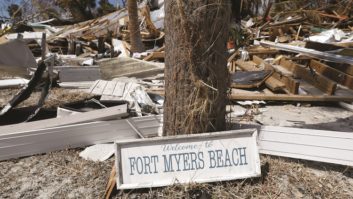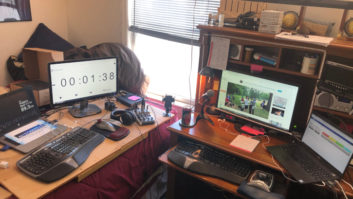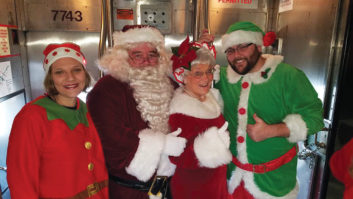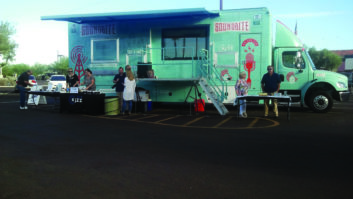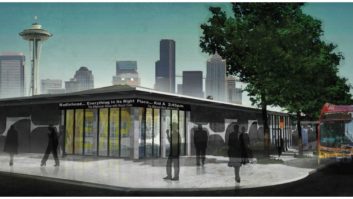On the phone with an engineer the other day, I heard him interrupt to chastise a co-worker trying to steal one of his cardboard boxes.
“You have so many,” came the reply. “Can’t you let me have just one?” Sounds familiar.
(click thumbnail)Equipment stays put when it’s locked down.
We may not be able to help with those boxes; but how about the problem of a missing hand truck?
Engineers at the Cox stations in Richmond, Va., found that it doesn’t help to simply label a truck as engineering property. Promotions has their own, yet the engineering hand truck often went missing anyway — later found in the back of a remote van, down the hall in sales, locked in the prize closet, you know the routine. So the engineers took it a step further.
Thanks to this lock and chain, the truck isn’t taken, used and then forgotten. Not that the engineers won’t share. But they make the person using the hand truck accountable for returning it.
Jon Bennett heads the engineering department at Cox Richmond.

. . .
No matter which market you work in, how many stations are in the group or the number of employees, some problems are universal among broadcast engineers.
The issue of food and drink in the studio is near the top of the list. The topic touches readers’ hot buttons, too.
Terry Skelton was the “tech sup” or engineering manager for the NBC television network news shows in New York many years ago. He and his staff felt it was illogical (as well as a losing battle) to try to go against human nature and needs.
Frequently, audio engineers worked long hours and exhausting swing shifts. That cup of coffee helped prevent errors; and management didn’t allow errors on the “Today” show or “The Nightly News.”
Terry installed teak cupholders, obtained from boat supply companies, in the audio booth and other locations. The cup holders would be mounted away from equipment (over a wastebasket, for instance), and usually at the blank end of the furniture at the end of the console. Drinks were allowed there, but only there. If that rule was broken, it was time for discipline.
The same solution could be applied to food, perhaps using a small rollaround table or one mounted against a wall. Food could be limited to that spot.
Just keep in mind one of the basic rules of electronics: If you put drinks near the gear, sooner or later someone, no matter how careful or good-intentioned, will spill it into the faders. Terry adds that he speaks from lots of personal experience.
Skelton is now a manager with a military, aerospace and government contractor in Santa Fe, N.M.
. . .
When engineering manages board ops or other engineers, disciplining errant behavior is one thing; but when it’s engineering against the programming staff, you may face a struggle to be heard.
Here’s the policy adopted at Clear Channel Orlando, home of five FMs, two 50-gallon AMs and the Florida State Network.
It’s a simple one, says engineer Frank Lovre: Any equipment damage due to food or drink spills is charged back to that station’s programming budget.
Now that will get some attention.
. . .
Althought plenty of tips roll in, we haven’t had as many do-it-yourself circuits lately, so here’s an incentive.
(click thumbnail)Got a good circuit idea? You can win this or another engineering-themed T-shirt.
Our editor Paul McLane has worked out a deal with the folks at the NAB Store to provide us with neat engineering-themed T-shirts to give away to the three best “home brew” circuit projects submitted to Workbench. (Paul and I will be the judges, and our decision will be final.)
This circuit can be an equipment modification that improves performance, or a bread-boarded circuit that you came up with to solve a problem at your stations. (Sorry, the idea for the relay that drops the jock’s headphone feed if the door to the audio processor rack is opened is already taken.)
E-mail or fax your entry using the information at the end of this article. Be sure to include a clear drawing of the schematic, a high-resolution digital picture of the device, a parts list and a description of what the circuit does.
So put a few bucks in your pocket and maybe a shirt on your back. Let’s hear from you talented readers.

. . .
(click thumbnail)A typical map detail for the FM auction from by Mullaney Engineering is shown.
The FM Auction 62 process is underway. By now your owner has filed a Form 175, indicating what allotments he or she is interested in. Before Sept. 30, bidders should look at the allowable areas and population served.
To assist with this evaluation, Jack Mullaney and his staff at Mullaney Engineering have a useful map package. The package includes allowable area maps for each auction channel. It also describes whether the channel can be immediately upgraded, and includes a separate map for that upgrade.
A population analysis uses the FCC as well as the Longley-Rice methods. Mullaney says tower heights were somewhat limited to be realistic.
The bid file identifies which of the allotments was in a previous auction; what, if any, the last bid was; and whether the bid was withdrawn or the bidder defaulted on payment. Coordination problems with Canada or Mexico or with a pending rule making are noted.
For information, contact Mullaney at (301) 921-0115.
Send ideas and submissions to jbisset@bdcast.com or fax to (603) 472-4944. Submissions for this column are encouraged, and qualify for SBE recertification credit






